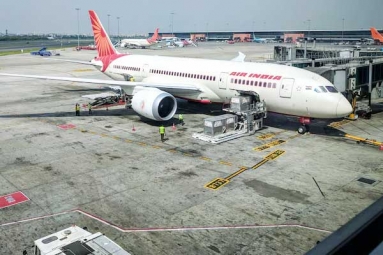
(Image source from: x.com/aviationbrk)
On June 12, Air India Flight 171, a Boeing 787-8 Dreamliner, left the Sardar Vallabhbhai Patel International Airport in Ahmedabad at 1:39 pm, going to London Gatwick. Only 32 seconds after it started flying, the plane crashed into a hospital building near the airport, and 241 of the 242 people on the plane and 19 people on the ground died. The only person who lived was a British-Indian man who was in seat 11A. This was the first big crash for the Boeing 787 since it started carrying passengers in 2011. A report from the Aircraft Accident Investigation Bureau (AAIB) came out last night. The report talks about different possible reasons for the crash and asks questions about what happened during the unlucky flight. Information from the plane&039;s Enhanced Airborne Flight Recorder (EAFR), also called the black box, showed that Flight 171 took off normally. The Dreamliner reached a speed of 153 knots, or about 283 km/h, when taking off. It then went as fast as 180 knots, or about 333 km/h, as it went higher, like it was supposed to. The flaps were set at five degrees, and the landing gear lever stayed in the &39;DOWN&39; position, which are both normal things to do when taking off.
The weather was good, it was easy to see far, and the winds were light, so there was no danger. But, in just a few seconds, the fuel control switches for Engine 1 and Engine 2 went from the "RUN" position to the "CUTOFF" position, one right after the other, in just one second. These switches manage how much fuel goes to the engines, and putting them on "CUTOFF" stopped the fuel, making both engines lose power. The black box information shows that the power from the engines went down from what it was at takeoff almost right away, causing the power to decrease fast. The cockpit voice recorder (CVR), which is part of the black box, recorded a short talk between the pilots. Captain Sumeet Sabharwal, who was watching the instruments, and First Officer Clive Kunder, who was flying the plane, were both good at their jobs and healthy, with no known problems that could affect their ability to fly. As the engines started to fail, one pilot — we don&39;t know which one yet — asked, "Why did you cut off?" The other one said, "I didn&39;t."
This conversation is very important for the investigation now. Was it just a mistake, something that someone did but didn&39;t say, or something else that the pilots couldn't control? The fuel control switches on a Boeing 787 are not just simple switches. Each switch has something protecting it. For a pilot to move a switch from "RUN" (forward) to "CUTOFF" (backward), they have to lift the switch up and push it down. This design helps stop the switch from moving by accident, like if a hand touches it during the flight. The switches for Engine 1 and Engine 2 are about two or three inches apart, so it's not likely that both would be turned off at the same time without someone meaning to do it. But, the information confirms that both switches went to "CUTOFF" in just one second.
As the power went down, the plane began to lose altitude. The flight recorder shows the pilots quickly responded, moving both fuel switches to the "RUN" position. This action, taken around 10 seconds after the first fuel loss, was meant to restore fuel and restart the engines. Engine 1 worked well, stopping its core speed from decreasing, turning it around, and beginning to pick up speed with more power. Engine 2 also came back on, but its core speed kept dropping even after many attempts to add fuel and increase the recovery. The thrust levers, discovered almost at the idle position in the wreckage, had been pushed forward until the crash, according to the flight data recorder. Also, the Ram Air Turbine (RAT), a small fan that opens on its own if both engines fail, came out from the plane's body during takeoff. Airport security camera footage showed this happening.
The RAT gives power to keep key systems working, but it does not create thrust. With the plane just a few hundred feet off the ground, the slight recovery of Engine 1 was not enough. At 1:39:32 pm, Flight 171 crashed into the hostel, causing an explosion that destroyed the area. The AAIB&039;s first report, which is very detailed, used data taken from the heavily damaged flight recorders, one in the front and one in the back. These devices, made to survive high heat and crashes, hold memory chips that record flight details. The United States&039; National Transportation Safety Board offered specific tools to help get back this data. The investigation is now centered on the fuel control switches.
Human Action: Did one of the pilots by mistake or on purpose move the controls? The talk in the cockpit suggests that neither pilot admitted responsibility. "No pilot in their right mind would do this. The switches need a clear action to lift and move them over a guard. They’re not something you flip by accident," said Captain Saurabh Bhatnagar, a former senior commander at Air India Express.









